Double Star of the Month Archive 2020
In this series of short articles, a double star in both the northern and southern hemispheres will be highlighted for observation with small telescopes, with new objects being selected for each month.
December 2020 - Double Star of the Month
About 5 degrees due south of alpha Persei (Mirfak) is the rather faint pair STF 391 (03 29 13.74 +45 02 57.5). The Washington Double Star (WDS) catalogue gives the magnitudes as 7.6 and 8.3 and the stars are currently 3".9, a value that has remained unchanged for 200 years or so.
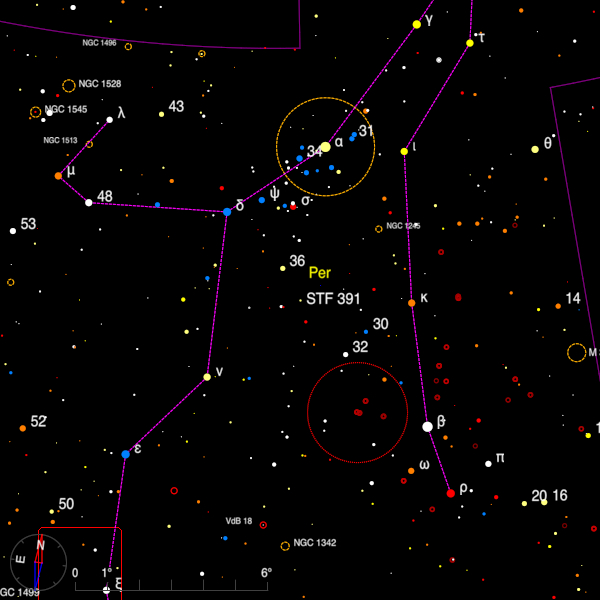
The primary is a B1 dwarf and its companion a giant star of spectral type G8. The colours of the stars might therefore be expected to be white and yellow. Sissy Haas in her book 'Double stars for small telescopes' gives the colours as white and red, as observed in her 60-mm refractor. On the other hand, when I observed them with a 21-cm reflector some years ago, I noted that there was a superb contrast of yellow and blue. I have not yet observed the stars in the Cambridge 8-inch refractor but will try to do so at an early opportunity.
The Gaia satellite provides a distance of about 3,100 light-years for each component with an error of about 150 light-years in each case. Whilst in the area check out S 430 (03 38 18.53 +44 48 06.5), approximately 2 degrees east and slightly south, a fine pair - 7.2, 7.5, 96 degrees, 41".
In the far south-eastern and rather sparse corner of Hydrus near the border with Octans is HJ 3568 (03 07 32.13 -78 59 21.3). This is one of John Herschel's Cape discoveries. The primary is a naked-eye star (+5.7) whilst some 15" distant is a magnitude 7.7 companion. In addition, A is also a spectroscopic binary and a delta Scuti variable, known as BN Hyi.

The stars are equally distant (263 light-years) according to Gaia DR2 and both are moving through space in the same direction and at similar velocity but there has been little change in the relative motion of the stars since the 1830s giving no clue as to the orbital period. Ernst Hartung notes that this is a fine, unequal pair yellow and bluish-white
.
Bob Argyle - Double Star Section Director
November 2020 - Double Star of the Month
Some 90 arc-minutes to the east of alpha Cas is the open cluster IC 1593 which is inside the nebulosity NGC 287. The cluster is dominated by a group of 9th and 10th magnitude stars which attracted the attention of S. W. Burnham soon after he obtained his 6-inch Clark refractor.

He found that the brightest star in the cluster (V = 8.6) is a close double. There is a magnitude 9.3 star at 1.5 arc-seconds distance, whilst star C is magnitude 8.9 is 4 arc-seconds away with another 9.7 (D) at 9 arc-seconds distance. It is not clear where this group ends and the cluster begins.
The WDS lists 16 components altogether with most of the stars lying between magnitudes 12 and 16. The accepted distance to the cluster is 2.94 ± 0.15 kiloparsecs whereas the parallax of star A in Gaia DR2 corresponds to a distance of 2.80 ± 0.38 kpc. The bright multiple is known as BU 1 (00 52 49.22 +56 37 39.5) although this was not actually the earliest Burnham discovery.
The southern part of this column in its second appearance in 2006 considered the glorious pair theta Eri or Acamar. Starting at this star and moving three degrees west you will alight upon the closer pair HJ 3527 (02 43 20.36 -40 31 38.8), also in Eridanus (as can be seen from the relevant map in the Cambridge Double Star Atlas, but the WDS catalogue mistakenly has it in Fornax - my thanks to James Whinfrey for pointing this out).
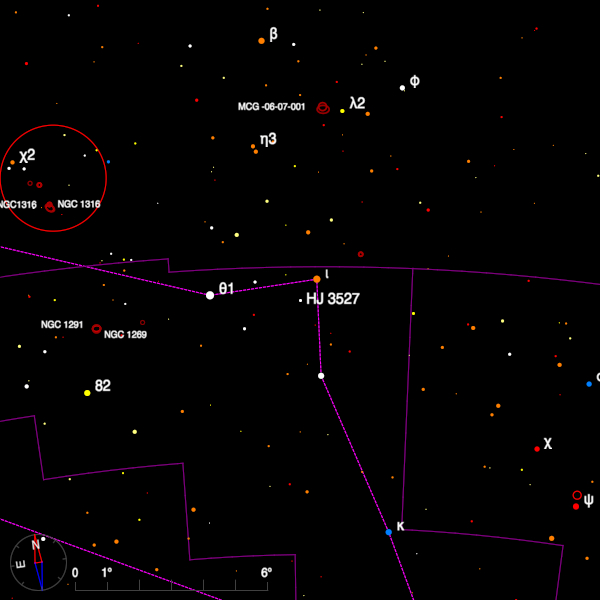
One of John Herschel's discoveries from Feldhausen, this is a beautiful pair, the primary of which is a late B dwarf. The magnitudes are 7.0 and 7.2 and the current separation of 2".3 appears to be increasing. Whilst observing this star in 2013 with the 67-cm refractor in Johannesburg, the writer found a faint and distant star of magnitude 11.6 at 133", unassociated with the bright pair.
Bob Argyle - Double Star Section Director
October 2020 - Double Star of the Month
In this column exactly 10 years ago, the fine binary star 72 Peg was described. It remains a severe test for 20-cm aperture but as the stars are almost equally bright at V=6, so separating the components, which are now 0".59 apart, is made somewhat easier.
About 2 degrees to the north-east is another Burnham discovery, BU 858 (23 41 17.6 +32 33 40), somewhat wider than BU 720 (BU 858 is 0".8 at present) but with components whose V magnitudes are 7.8 and 8.8 this is an equally challenging pair.
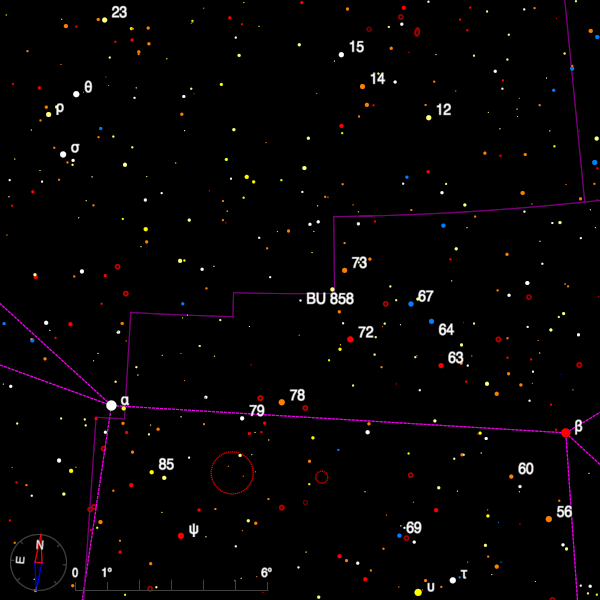
Since discovery in 1881 the companion has moved almost 60 degrees in position angle, but there is no orbit as yet. A magnitude 12.9 star at 23" is being left behind by AB and was also found by Burnham (BU 389) but earlier in his career and with the famous 6-inch refractor. Gaia DR2 does not give data on A and B but quotes a parallax for both stars of 6.66 mas, equivalent to 490 light-years. The faint star is much more distant and clearly optical.
The second edition of the Cambridge Double Star Atlas notes that tau Aqr is preceded, about 45 minutes to the south-west, by a somewhat fainter but still naked-eye star called 69 Aqr (22 47 42.7 -14 03 23). The SIMBAD catalogue also lists alternative names for tau and 69 as tau 2 and tau 1. Tau is unmistakeable - it a magnitude 4.0 star with a distinctly reddish hue - an MO giant in fact.

The closer pair, of which 69 Aqr is the brighter component, are separated by about 20" but this distance has been closing since 1781 when William Herschel found the stars 35".8 apart. Measures I made in 1994 and 2005 show the distance decreasing over that time interval. This is purely down to difference in proper motions as the stars are at significantly different distances. The pair is also known as STF 2943. The WDS notes that A is also a spectroscopic binary and a putative faint and distant companion found in 1918 does not exist. Herschel noted colours of reddish-white and dusky. A is a hot blue dwarf of spectral type B9 and the companion has a somewhat later spectral type, but Simbad does not elaborate.
Bob Argyle - Double Star Section Director
September 2020 - Double Star of the Month
STF2872 (22 08 36.04 +59 17 22.2) is located in Cepheus about 1¼ degrees north and slightly west of zeta Cep (a distinctly reddish star of magnitude 3.4). To the small telescope it appears as a wide pair. The catalogue magnitudes are 7.1 and 8 and the current separation almost 22 arc seconds.

When F. G. W. Struve examined the system during his great survey at Dorpat he noted that the companion was a close pair with a separation of around 0".5. Since then the position angle has decreased about 40 degrees and the separation has slowly increased giving a position angle of 296 degrees and separation 0".80 in autumn 2020. I was able to measure this pair in 2016 with the Cambridge 20-cm refractor and it may be divisible in 15-cm. The 840 year orbit shows the stars slowly closing, reaching 0".2 in 100 years time, but for the foreseeable future a moderate aperture will suffice. Gaia DR2 does not show BC as two stars, rather surprising as many pairs wider than 0".5 appear as two entries in that catalogue.

Surprisingly missing from Hartung's Astronomical Objects for Southern Telescopes, 57 Aql (19 54 37.65 -08 13 38.3) is one of the finest pairs in Aquila. The stars are of magnitude 5.7 and 6.4 and both are late B dwarf stars.
It might be expected that both stars appear white but there have been wide variations in reported colours. Webb in 1851 thought they were distinctly contrasted pale yellow and pale blue whilst he notes in 1855 cols. entirely diff.
Smyth though both were pale blue whilst Struve reported both stars as white. I have often wondered if the colour of a star can appear to change if it is a spectroscopic binary, especially if the components have different spectral types and the orbits are almost edge-on to the plane of sight. The WDS notes tell us that both components are, in fact, SBs, whilst the paper by Chini et al. in 2012 notes both stars have constant radial velocities.
There has been no change in relative position in the last 200 years with the two stars fixed at 171 degrees and 35".5. William Herschel noted 29".5 in 1781 which may suggest a misreading of his micrometer screw. Gaia DR2 places them 440 light years away; within the search radius of 150 arc-seconds, I also noted a magnitude 20 star with nominal parallax slightly greater than 57 Aql A and B but with an error of 30%.
Bob Argyle - Double Star Section Director
August 2020 - Double Star of the Month
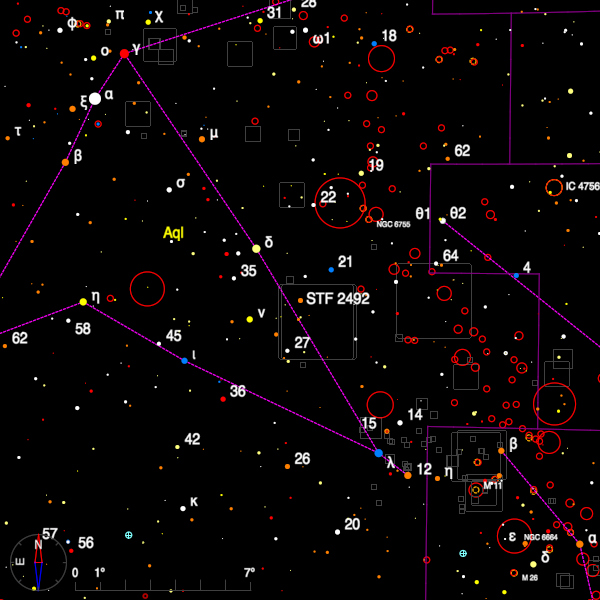
In preparing this column I checked my list of measures for 23 Aquilae = STF 2492 (19 18 32.50 +01 05 06.5) and found to my surprise that I had never observed it with the 8-inch refractor.
William Herschel first noted it in 1781 when he recorded Excessively unequal; the small star is just visible with 227..
. Since then the stars appear to be widening and Gaia DR2 astrometry puts them at 2 degs and 3".27 for 2015.5. The Gaia results show that they are not strictly at the same distance - the difference
between the parallaxes for each component is about ten times as large as the quoted
error in the distance of B, although the error on the bright star is large and may be expected to be improved upon when the Gaia Early DR3 catalogue is issued. This was supposed to happen in the next month or two, but it now seems likely it will be put back due to COVID-19.

Also in Aquila is STF 2597 (19 55 19.50 -06 44 05.22), another system which has not graced my eyepiece. One reason for this is that in the early 1970s it was only 0".04 apart and has been slowly widening since then.
The USNO 6th catalogue of orbits shows a highly elongated apparent orbit and the eccentricity of the true orbit is actually 0.94, one of the highest known. The stars are also quite unequal (6.9 and 8.0) which adds to the difficulty of visual resolution.
The great Italian observer Ercole Dembowski suspected an elongation of the brighter star in PA 140 degrees in 1864 but this has not been confirmed. More than 50 observations over the last 40 years with speckle cameras on large telescopes have not shown a third component.
The 425 year orbit for this system puts the components at 100 degrees and 0".75 for 2020.5. STF 2597 can be found just 1.5 degrees north of the pretty pair 57 Aquilae, more on which will appear in next month's column.
Bob Argyle - Double Star Section Director
July 2020 - Double Star of the Month
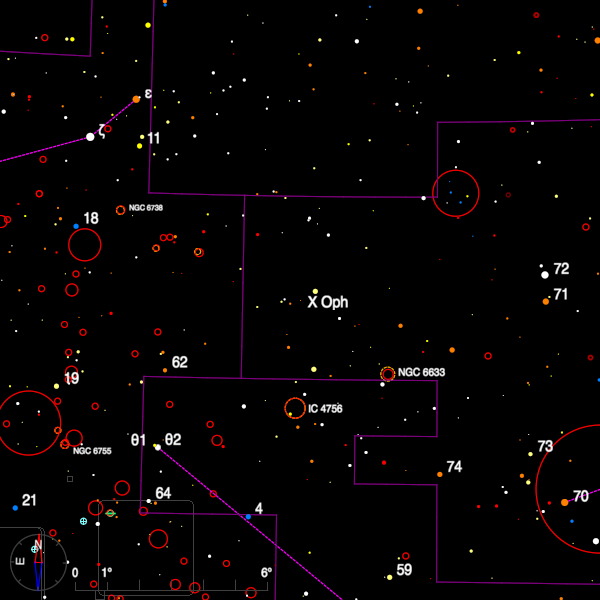
Mira was not the first Long Period Variable to be shown to be a visual binary. T. H. E. C. Espin found X Oph (18 38 21.13 +08 50 02.6) in 1886 and in 1900 William Hussey, observing at Lick Observatory, noted that the star was a close pair and catalogued it as HU 198. On several nights with the 36-inch refractor he saw two equally bright stars at a separation of 0".2. Later spectroscopic observation showed that the star spectrum was composite with a K giant combined with an M6 giant. George van Biesbroeck, when observing X Oph visually noted its very deep orange colour.
Since then the stars have separated somewhat and in 2018 the companion was found to be at 126 degrees and 0".5. This fact, and also that X Oph has only a 3.3 magnitude amplitude, and the companion is significantly brighter than Mira B makes this star easier to resolve than Mira, although at least 30-cm would be needed, preferably.
An ephemeris for X Oph gives a maximum brightness on Feb 5, 2020 and Jan 8, 2021 so during July 2020 the variable should be near minimum and therefore helps visual resolution. It is also 10 degrees higher in the sky than Mira. X Oph can be found 4 degrees due north of the open cluster IC 4756 or 18 degrees due west of Altair. According to David Boyd of the BAA Variable Star Section, the primary ranges from V = 6.5 to 9.8 whilst the B star is magnitude 9.0. Gaia DR2 gives a parallax for the variable of 4.66 ± 0.30 mas or 700 ± 45 light-years but there is no entry for the companion.

SEE 316 (17 00 26.96 -48 38 52.2) is in northern Ara and lies 2.5 degrees due east of DUN 211 which was described in May's column.
A discovery of T. J. J. See, this fine pair can be well resolved in 15-cm. The stars are magnitudes 6.3 and 7.7 according to the Washington Double Star Catalog (WDS) and when the writer last measured them in 2016 the position angle and separation were 173 degrees and 1 arc-second. This represents a small increase in angle and a doubling of separation since the first observation in 1897.
Hipparcos gives a distance of about 350 light-years but with a significant error. Surprisingly, the stars do not appear in the Gaia DR2 catalogue even though significantly closer pairs are included. E. J. Hartung noted that the field is rich in faint stars.
Bob Argyle - Double Star Section Director
June 2020 - Double Star of the Month
In this column for July 2013, I included the difficult pair 26 Dra. One of Burnham's discoveries at the time of writing it was closing and by mid-2020 it will be widening (186 degrees, 0".5) but will still probably require 30-cm and a good night as the stars are almost 3 magnitudes apart.
Attention this month turns to STF2218 (17 40 18.07 +63 40 31.4) which is 2 degrees N of 26 Dra and slightly E. Discovered at Dorpat by F. G. W. Struve this pair has been closing slowly over two centuries but is still within range of 10-cm. The components are magnitudes 7.1 and 8.4 and at 2020.5 they can be found at 307 degrees and 1".4. The orbit is preliminary as the angular motion amounts to just 50 degrees and predicts a period of 2130 years.
R. T. A. Innes used a 7-inch refractor at the Cape Observatory around 1900 to survey the sky for new double stars and to take up work again which he was doing as an amateur astronomer in Australia about 5 years before.
One of his discoveries was I 333 (15 39 55.12 -78 01 38.1), a relatively bright and easy pair with magnitudes 6.9 and 7.5 and 0".8 apart when he happened upon them. He was not the discoverer though. This was Solon Bailey who found the pair from Arequipa in Peru in July 1897 but the observation did not get published until 1908 so Innes got the credit.
When Willem van den Bos made a pair of mean measures from Johannesburg around 1930 the stars were just 0".3 apart and clearly in rapid motion. The WDS Observations Catalogue then reports no further observations until 1990, a stretch of almost 60 years. By then they stars were almost back to where they were discovered and it seems that here is a binary with a period of about 150 years.
I 333 was brought to my attention by Andrew James who had noted the probable binary nature of the pair and at my request Rainer Anton secured a measure in Namibia in mid-2019. His result was 323 degrees 0".85.
Like iota Octantis in April this pair is close to the South Pole but should repay observation with 15 or 20-cm.
Bob Argyle - Double Star Section Director
May 2020 - Double Star of the Month
Epsilon Bootis (14 44 55.44 +27 04 29.9) is one of the best-loved and most well-known of visual double stars - and one of the brightest - its components are 1.9 and 4.8 in the Gaia G band - the equivalent of Johnson V.
Its spectacular colours prompted F. G. W. Struve to call it Pulcherrima (most beautiful). It was found by William Herschel and was catalogued by him as H I 1. W. H. Smyth calls it pale orange and sea green but leaves any discussion of it out of his book Sidereal Chromatics. Apertures of 15-cm will show it well, especially if a higher magnification is used.
Gaia DR2 includes both components but does not give a parallax for the bright star. The quoted error in the parallax for B is significantly larger than normal, which may be due to the proximity of A or the fact that B is a spectroscopic binary, although it does not appear in the Ninth Spectroscopic Binary catalogue. DR2 makes the distance of B to be 219 ± 6 light-years. The pair appear to be physical with the position angle having increased about 45 degrees to 347 degrees in 2018. The distance at that epoch is 2".8 which has changed little since 1777. Assuming the orbit is circular then the period will be about 2,000 years.
The galactic equator passes through the north-east corner of Ara and close to the very young cluster NGC 6193, which in turn is just east of the HII region NGC 6188. About 1 degree ENE of NGC 6193 is the wide binocular triple star DUN 211 (16 47 28,13 -48 19 10.1).
The brightest pairing (AB) is stars of magnitude 6.5 and 8.1 in the G band of Gaia. The primary is clearly a red star and is a bright M giant whereas the companion 106" distant in PA 125 degrees is early F. The third obvious component can be found at 144 degrees and 130" and has G = 8.1. However, 10-cm aperture should be sufficient to show the close companion to C found by John Herschel at the Cape (HJ 4885). D is 3".8 away in PA 239 degrees, and both C and D have similar parallaxes and proper motions. Gaia DR2 puts them at around 440 light-years. Star B is unconnected and star A is much more distant than its companions.
Bob Argyle - Double Star Section Director
April 2020 - Double Star of the Month
Six degrees NE of delta Leonis is 54 Leo (10 55 36.80 +24 44 59.0). It is an attractive and brightbut unequal pair (V magnitudes 4.5 and 6.3) which is well seen in small apertures.
It is H 3 30 in William Herschel's catalogue and the great observer noted the colours as white and ash-colour or greyish-white. Struve catalogues it as STF 1487 and Admiral Smyth found them white and grey whilst Webb noted greenish-white and blue and in 1972, I recorded white and blue using a 25-cm reflector.
Gaia DR2 finds that the parallaxes for A and B are respectively 9.83 and 10.17 milliarcseconds corresponding to distances of 332 and 321 light-years, although the error on the A component parallax is 12 light-years, indicating the possibility of another star in the system. In 2018, a measure made with the Cambridge 8-inch refractor put the stars at 114.3 degrees and 6".5.
The most southerly double star to appear in this series so far is iota Octantis (12 54 58.80 -85 07 24.1).
It came to light as a double star in April 1935 when Robert Rossiter was surveying the sky with the 27.5-inch refractor at the Lamont-Hussey Observatory in Bloemfontein, South Africa. He found a pair of stars with magnitudes 5.5 and 6.3 at 0".67 and numbered the pair RST 2819.
Unless the stars have widened significantly, it is difficult to understand why they were not found before by southern observers. Perhaps the closeness of the stars to the southern celestial pole where traditional refractors are hard to maneouvre played a part.
Since discovery the stars have moved just 13 degrees and shown little motion in separation. The last observation in 2006 put them at 240 degrees and 0".7, and they were elongated by Ross Gould with 17.5-cm; he noted the primary was orange. In 1941 Willem van den Bos added a third star of mag. 10.9, currently at 53 degrees and 62".
Bob Argyle - Double Star Section Director
March 2020 - Double Star of the Month
STF 1728 = 42 Com = alpha Com (23 09 59.29 +17 31 46.0) is probably the shortest period visual binary star which is resolvable in 20-cm but such is the nature of the apparent orbit that it can only be seen briefly.
The apparent motion in the 26 year orbit is in a straight line because the orbit is edge-on to the line of sight and in this case it seems that the stars do undergo mutual eclipses although the last such event in late 2014, was missed because the orbit used had been biassed just enough by three observations (out of 600) that the time of eclipse occurred several weeks before the date on which they were widely expected to reach conjunction. For full details see Astronomy Now for December 2014.
In Spring of 2020 the components are at 0".47 but they are now closing at the rate of 0".08 per year. I measured them for the first and only time in April 2018 when the separation found was 0".59. The stars are magnitude 4.9 and 5.5 and 42 Com can be found 6.5 degrees north and 2 degrees east of epsilon Vir.
James Dunlop found a number of his bright wide discoveries in the rich star fields of the southern summer sky. DUN 78 (09 30 46.09 -31 53 21.2) consists of the stars zeta1 and zeta2 Antliae which, taken together, are just visible to the naked-eye.
This pair of A1 dwarf stars have magnitudes 6.2 and 6.8 and form a beautiful sight for the small aperture. They clearly form a long-period binary system as the Gaia DR2 results shows that their distances are respectively 350.0 and 347.0 light-years with formal errors of 2.2 light-years on each value.
Hipparcos found that the A component was a close unequal double (0".4 and closing) whilst B is accompanied by a faint M dwarf also at 0".4 which was found in the K band. It seems likely that this is a physical quadruple.
Despite the spectral types Ross Gould using 175-mm found that both components were light yellow.
Bob Argyle - Double Star Section Director
February 2020 - Double Star of the Month
Starting at the fine pair 38 Gem (see this column for Feb. 2016) and moving 2 degrees due East, brings the observer on the pair STF 1007 (07 00 37.52 +12 43 24.2) and, a further 20 arc-mins East, upon HJ 3288.
The brighter and wider of the two is STF 1007 which was left out of Lewis' treatise on the Dorpat pairs because it was too wide (the writer found 28 degrees, 67".4 in 2014). In fact, Burnham noted two fainter and closer companions on March 16, 1873 with his 6-inch refractor, neither of which could be seen in the 8-inch Thorrowgood with the micrometer field illumination on. C is 11.4 at 300 degrees, 15" and D is 10.0 at 244 degrees, 22" whilst Burnham called them magnitudes 14 and 12 respectively. The Washington Double Star Catalog (WDS) notes that D was found to be a close lunar occultation double.
HJ 3288 is a pair with magnitudes 7.3 and 8.7 and the writer found 217 degrees, 38" in 2013.
Originally found as a close bright pair by F. G. W. Struve, STF 1104 (07 29 21.91 - 14 49 53.40) turns out to be a physical quintuple system. The AB pair has magnitudes of 6.4 and 7.6 and at discovery was found at 292 degrees, 2".4. At 2017 it was 38 degrees, 1".8 and a preliminary orbit was computed by A. A. Tokovinin in 2014 who found a period of 729 years. This predicts a minimum separation of 1".7 around 2045 so the pair is always within range of 10-cm.
In the 1880s two further stars were noted - an 11.8 at 20" (C) and a 13.2 at 72" (D). Since then D has been rapidly left behind by the considerable proper motion of AB, which is 0".3 per year. C, however, is keeping pace and is clearly physical. Dr. Tokovinin also found that C was a close pair of dwarf stars separated by 0".1 and also noted that a star 1072" away which was noted by Luyten and labelled LP 722-24, is also moving through space with a similar proper motion and distance.
The group is 120 light years from us.
Bob Argyle - Double Star Section Director
January 2020 - Double Star of the Month
118 Tau (= STF 716) is well-placed for observing in mid-evening (RA 05 29 16.49 +25 09 01.1) and can be located almost half-way between the stars forming the points of the 'horns' of Taurus, (zeta and beta Tauri).
It is a distinctly neat pair for the small aperture - 10 or 15 cm will show it very well. First noticed by Herschel (H 2 75) this pair of B and A type dwarfs appeared white and pale blue or white and bluish to the early observers.
With little change of separation over 200 years (it is currently 4".7) the position angle has increased by 27 degrees to its current value of 210 degrees and Gaia DR2 shows that the parallaxes of the components are similar but not identical, being 8.96 mas ± 0.10 mas for the magnitude 5.8 A, and 8.42 ± 0.12 mas for B (magnitude 6.7).
In late 2002 Roberts and colleagues found faint companions to both A (at a distance of 1".7) and B at a distance of 1" but no confirmatory measures have yet been made. There is a 11.9 magnitude field star 140" away in PA 99 degrees.
The constellation of Lepus is unfortunately low in the sky for UK observers but repays some attention as there are attractive double stars to be found, especially if the seeing is good.
38 Leporis (RA 05 20 26.91 -21 14 23.1) is 2 degrees WSW of beta Leporis and was discovered by John Herschel (HJ 3750) from the Cape in November 1835 with the comment A most beautiful double star
.
The magnitudes are 4.7 and 8.5, whilst the stars appearing to be slowly widening. In 2015 they were at 279 degrees and 4".0. Observing from Victoria in Australia, Ernst Hartung found them pale yellow and white, as did Sissy Haas adding easily seen with 75-mm
.
If the seeing is good then try beta Lep itself. This Burnham pair is magnitude 2.9 and 7.5 at 8 degrees, 2".7 substantially different from the discovery PA 268 degrees indicating significant orbital motion. Gaia DR2 appears to show a third component with G mag 8.68 (similar to V) at a distance of 1".3 which may be new.
Bob Argyle - Double Star Section Director